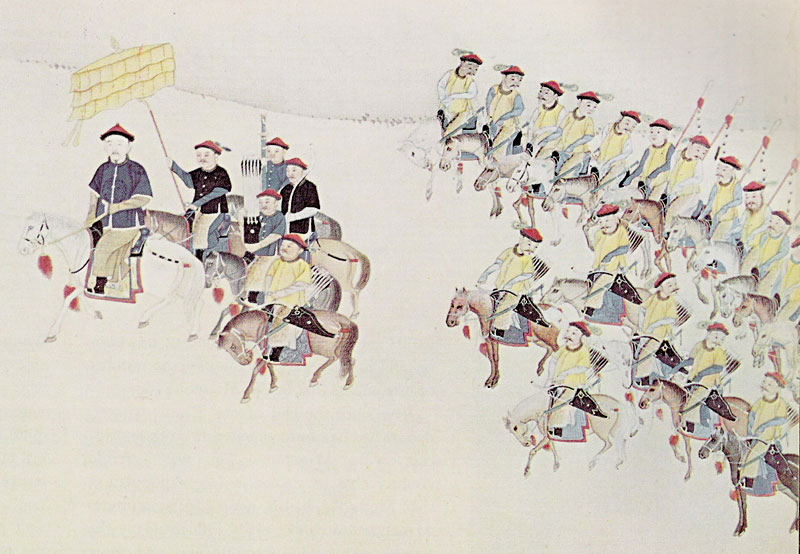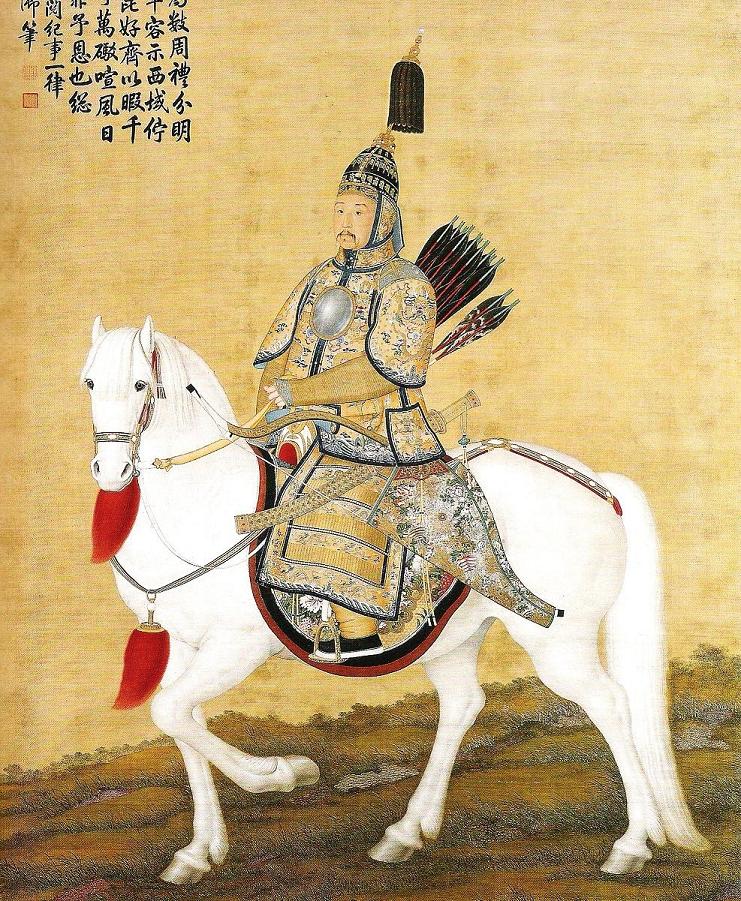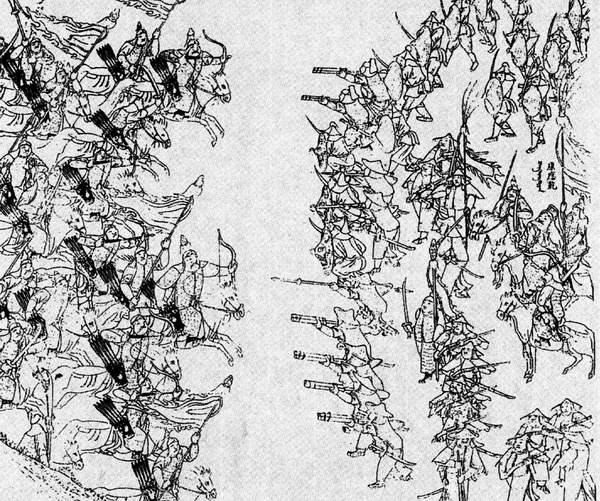|
Yuntao
Yuntao (; 18 January 1686 - 1 September 1763) was a Qing dynasty imperial prince and the 12th son of the Kangxi Emperor. Yuntao was rather a crony of the Yongzheng Emperor and his adoptive brother, which helped him persist in the succession war. He became the first bearer of the Prince Lü of the First Rank title. Life Yuntao was born on 18 January 1686 to Concubine Ding, Wanlioha Niuniu (完琉哈•妞妞). In his childhood, he was taught by Sumalagu, a confidant of Empress Dowager Xiaozhuang. In 1695, Yuntao was awarded a yellow riding jacket for his excellence in martial arts Yunzhi once recalled that Yuntao addressed Sumalagu as Azhagu (阿扎姑,meaning "careful" in Manchu language). When Sumalagu fell critically ill in 1705, Yuntao personally took care of her. In 1709, Yuntao was granted a title of the prince of the fourth rank for his merits. After Kangxi Emperor's death, Yuntao controlled Bordered Yellow Banner, in contradiction to the earlier records claiming hi ... [...More Info...] [...Related Items...] OR: [Wikipedia] [Google] [Baidu] |
Prince Lü
Prince Lü of the First Rank, or simply Prince Lü, was the title of a princely peerage used in China during the Manchu-led Qing dynasty (1644–1912). As the Prince Lü peerage was not awarded "iron-cap" status, this meant that each successive bearer of the title would normally start off with a title downgraded by one rank ''vis-à-vis'' that held by his predecessor. However, the title would generally not be downgraded to any lower than a ''feng'en fuguo gong'' except under special circumstances. The first bearer of the title was Yuntao (1686–1763), the 12th son of the Kangxi Emperor. In 1722, Yuntao was made a ''junwang'' (second-rank prince) by his father for his military achievements. However, a year later, he was demoted two grades to ''beizi'', but was restored as a ''junwang'' in 1730. In 1735, he was promoted to ''qinwang'' (first-rank prince) under the title "Prince Lü of the First Rank". The peerage was passed down over eight generations and held by eight persons ... [...More Info...] [...Related Items...] OR: [Wikipedia] [Google] [Baidu] |
Yongcheng (prince)
Yongcheng (, 21 February 1739 - 5 April 1777) was an imperial prince of Qing Dynasty. Life Yongcheng was born on 21 February 1739 as the Qianlong Emperor's fourth son. His mother, Imperial Noble Consort Shujia, was entitled "Concubine Jia" at that time. In 1763, Qianlong Emperor decided to adopt him into Prince Lü peerage as a grandson of Yuntao, Kangxi Emperor's 12th son because all the children of the prince Lüyi died prematurely. Yongcheng held the title Prince Lü of the Second Rank until his death on 5 April 1777. He was posthumously honoured as Prince Lü Duan of the First Rank (履端親王; meaning "implementing in a dignified way") in 1799. Family Primary Consort * Imperial Princess Consort Luduan, of the Niohuru clan (履端亲王福晋 钮祜禄氏; 1751-1754)Titles: Primary Consort of the Fourth Prince (皇四子嫡福晋), ''Primary'' ''Consort of Prince Lu of the Second Rank'' (履郡王福晋), ''Imperial Princess Consort Luduan'' (履端亲王福晋) * ... [...More Info...] [...Related Items...] OR: [Wikipedia] [Google] [Baidu] |
Kangxi Emperor
The Kangxi Emperor (4 May 165420 December 1722), also known by his temple name Emperor Shengzu of Qing, personal name Xuanye, was the third emperor of the Qing dynasty, and the second Qing emperor to rule over China proper. His reign of 61 years makes him the longest-reigning emperor in Chinese history and one of the longest-reigning rulers in history. He is considered one of China's greatest emperors. The third son of the Shunzhi Emperor, Kangxi was enthroned at the age of seven while actual power was held for six more years by the four regents nominated by his father. After assuming personal rule, Kangxi's attempt to revoke the fiefdoms of feudal princes sparked the Revolt of the Three Feudatories, which he suppressed. He also forced the Kingdom of Tungning in Taiwan and Mongols in the north and northwest to submit to Qing rule, and launched an expedition that incorporated Tibet into the empire. Domestically, he initially welcomed the Jesuits and the propagation of ... [...More Info...] [...Related Items...] OR: [Wikipedia] [Google] [Baidu] |
Kangxi Emperor's Sons
The Kangxi Emperor (4 May 165420 December 1722), also known by his temple name Emperor Shengzu of Qing, personal name Xuanye, was the third emperor of the Qing dynasty, and the second Qing emperor to rule over China proper. His reign of 61 years makes him the longest-reigning emperor in Chinese history and one of the longest-reigning rulers in history. He is considered one of China's greatest emperors. The third son of the Shunzhi Emperor, Kangxi was enthroned at the age of seven while actual power was held for six more years by the four regents nominated by his father. After assuming personal rule, Kangxi's attempt to revoke the fiefdoms of feudal princes sparked the Revolt of the Three Feudatories, which he suppressed. He also forced the Kingdom of Tungning in Taiwan and Mongols in the north and northwest to submit to Qing rule, and launched an expedition that incorporated Tibet into the empire. Domestically, he initially welcomed the Jesuits and the propagation of Catholi ... [...More Info...] [...Related Items...] OR: [Wikipedia] [Google] [Baidu] |
Fuca Clan
Fuca (Manchu: ; ) was a clan of Manchu nobility. After the demise of the dynasty, some of its descendants sinicized their clan name to the Chinese surnames '' Fu'' (富/傅) or '' Li'' (李). Notable figures Males * Arantai (; d. 1699), served as the Minister of Works from 1687–1688 ** Funingga (; d. 1728), Arantai's son; political figure * Maci (1652–1739), political figure * Fuheng (1720–1770), Maci's nephew; political and military figure ** Fulong'an (; 1746–1784), Fuheng's second son ** Fuk'anggan (1754–1796), Fuheng's son; general *** Delin, Fuk'anggan's son * Mingliang (; 1736–1822), Fuheng's nephew * Mingrui (d. 1768), Fuheng's nephew; general * Fumin (; 1673–1756), official * Jingshou (; 1829–1889), served as one of the Eight Regents of the Tongzhi Emperor ** Zhiduan (; d. 1871), Jingshou's son by Princess Shou'en ; Prince Consort Females Imperial Consort * Empress ** Empress Xiaoxianchun (1712–1748), the Qianlong Emperor's first empress, the ... [...More Info...] [...Related Items...] OR: [Wikipedia] [Google] [Baidu] |
Sumalagu
Sumalagu (; originally Sumal, in Manchu ; 1615 – 24 October 1705) was a palace attendant of the Qing dynasty. She was a close confidante of Empress Dowager Xiaozhuang during the reign of the Shunzhi Emperor. Empress Dowager Xiaozhuang called her " Gege", a title reserved for only imperial princesses. She acted as the messenger between prince Shizu and his mother during the reign of Dorgon. Upon the wish of the empress dowager, she escorted empress Borjigit incognito to receive medical treatment by the Jesuit Adam Schall von Bell. Sumalagu taught the young Kangxi Emperor the Manchu language while he was under her care. She was a supporter of the Kangxi Emperor when he asserted his power against the power base of Oboi Oboi (Manchu: , Mölendorff: Oboi; ) (c. 1610–1669) was a prominent Manchu military commander and courtier who served in various military and administrative posts under three successive emperors of the early Qing dynasty. Born to the Guwalg ... in 1667–6 ... [...More Info...] [...Related Items...] OR: [Wikipedia] [Google] [Baidu] |
Gūwalgiya
Gūwalgiya was one of the most powerful Manchu clans. It is often listed by historians as the first of the eight prominent Manchu clans of the Qing dynasty. After the demise of the dynasty, some of its descendants sinicized their clan name to the Han Chinese surname ''Guan'' (). History Origins and Early History The Gūwalgiya clan can be traced back to the Jurchen people in the early 13th century, specifically the Jianzhou Jurchen tribes. The Name "Gūwalgiya" originally had been referred to a geographical location and later on was adopted as a clan name. The clan is believed to have originated from the Yalu River region (present-day Liaoning Province), around the area known as Sā'ěrhǔ (萨尔浒). During the late 16th century, Gūwalgiya Gāha, the son of Gūwalgiya Sōngāli, became the chieftain of Sā'ěrhǔ (萨尔浒) and allied with Nurhaci, the founder of the Later Jin dynasty. This alliance was an important piece in the establishment of the Later Jin and l ... [...More Info...] [...Related Items...] OR: [Wikipedia] [Google] [Baidu] |
Aisin-Gioro
The House of Aisin-Gioro is a Manchu clan that ruled the Later Jin dynasty (1616–1636), the Qing dynasty (1636–1912), and Manchukuo (1932–1945) in the history of China. Under the Ming dynasty, members of the Aisin Gioro clan served as chiefs of the Jianzhou Jurchens, one of the three major Jurchen tribes at this time. Qing bannermen passed through the gates of the Great Wall in 1644, and eventually conquered the short-lived Shun dynasty, Xi dynasty and Southern Ming dynasty. After gaining total control of China proper, the Qing dynasty later expanded into other adjacent regions, including Xinjiang, Tibet, Outer Mongolia, and Taiwan. The dynasty reached its zenith during the High Qing era and under the Qianlong Emperor, who reigned from 1735 to 1796. This reign was followed by a century of gradual decline. The house lost power in 1912 following the Xinhai Revolution. Puyi, the last Aisin-Gioro emperor, nominally maintained his imperial title in the Forbidden City until t ... [...More Info...] [...Related Items...] OR: [Wikipedia] [Google] [Baidu] |
Qianlong Emperor
The Qianlong Emperor (25 September 17117 February 1799), also known by his temple name Emperor Gaozong of Qing, personal name Hongli, was the fifth Emperor of China, emperor of the Qing dynasty and the fourth Qing emperor to rule over China proper. He reigned officially from 1735 until his abdication in 1796, but retained ultimate power subsequently until his death in 1799, making him one of the longest-reigning monarchs in history as well as one of the longest-lived. The fourth and favourite son of the Yongzheng Emperor, Qianlong ascended the throne in 1735. A highly ambitious military leader, he led Ten Great Campaigns, a series of campaigns into Inner Asia, Burma, Nepal and Vietnam and suppressed rebellions in Jinchuan County, Jinchuan and Taiwan. During his lifetime, he was given the deified title Emperor Manjushri by the Qing's Tibetan subjects. Domestically, Qianlong was a major patron of the arts as well as a prolific writer. He sponsored the compilation of the ''Siku Qu ... [...More Info...] [...Related Items...] OR: [Wikipedia] [Google] [Baidu] |
Qing Dynasty Imperial Princes
The Qing dynasty ( ), officially the Great Qing, was a Manchu-led imperial dynasty of China and an early modern empire in East Asia. The last imperial dynasty in Chinese history, the Qing dynasty was preceded by the Ming dynasty and succeeded by the Republic of China. At its height of power, the empire stretched from the Sea of Japan in the east to the Pamir Mountains in the west, and from the Mongolian Plateau in the north to the South China Sea in the south. Originally emerging from the Later Jin dynasty founded in 1616 and proclaimed in Shenyang in 1636, the dynasty seized control of the Ming capital Beijing and North China in 1644, traditionally considered the start of the dynasty's rule. The dynasty lasted until the Xinhai Revolution of October 1911 led to the abdication of the last emperor in February 1912. The multi-ethnic Qing dynasty assembled the territorial base for modern China. The Qing controlled the most territory of any dynasty in Chinese history, and ... [...More Info...] [...Related Items...] OR: [Wikipedia] [Google] [Baidu] |
Borjigin
A Borjigin is a member of the Mongol sub-clan that started with Bodonchar Munkhag of the Kiyat clan. Yesugei's descendants were thus said to be Kiyat-Borjigin. The senior Borjigids provided ruling princes for Mongolia and Inner Mongolia until the 20th century.Humphrey & Sneath, p. 27. The clan formed the ruling class among the Mongols and some other peoples of Central Asia and Eastern Europe. Today, the Borjigid are found in most of Mongolia, Inner Mongolia and Xinjiang, and genetic research has shown that descent from Genghis Khan and Timur is common throughout Central Asia and other regions. Origin and name The patrilineage began with Blue-grey Wolf (Börte Chino) and Fallow Doe (Gua Maral). According to '' The Secret History of the Mongols'', their 11th generation descendant Dobu Mergen's widow Alan Gua the Fair was impregnated by a ray of light. Her youngest son became the ancestor of the later Borjigid. He was Bodonchar Munkhag, who along with his brothers s ... [...More Info...] [...Related Items...] OR: [Wikipedia] [Google] [Baidu] |
Yunzhi, Prince Cheng
Yunzhi (23 March 1677 – 10 July 1732), also known as Yinzhi, was a Manchu prince of the Qing Dynasty. Biography Yinzhi was born of the Manchu Aisin Gioro clan as the third son of the Kangxi Emperor. His mother was Consort Rong (榮妃; d. 28 March 1727) from the Magiya clan and was the daughter of Gaishan (蓋山), who served as an Imperial Examination Examiner (員外郎). Yinzhi was granted the title of "Prince Cheng of the Second Rank" (誠郡王) in 1698. Yinzhi was known to be studious as a child and was versed in literary arts. His talents earned him the appreciation of his father. French Jesuit Joachim Bouvet once mentioned in a letter to King Louis XIV that the Kangxi Emperor personally taught Yinzhi geometry. When the Kangxi Emperor opened a school in Changchun Gardens (暢春園), he placed Yinzhi in charge of compiling a book titled ''Lü Li Yuan Yuan'' (律歷淵源), which included the '' shi-er-lü'', calendrical calculations, and mathematics. Yinzhi w ... [...More Info...] [...Related Items...] OR: [Wikipedia] [Google] [Baidu] |






